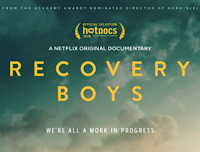Most Americans can appreciate that people suffering from addiction—even those who do not believe it is a disease—are in the grips of total despair. Thanks in part to an ever-escalating opioid addiction epidemic the media maintains constant coverage over opioid use in America. Most of the stories, including several documentaries produced in recent years, center around the deadly cost of addiction. The spotlight usually shines on the grimmest aspects of substance use and abuse. Images of a parent overdosing in the front seat of a vehicle while their toddler whelps in the back; some 115 people dying each day from opioid-related causes in 2016; and, a severe lack of funding and a shortage of beds to facilitate the roughly 2.1 million Americans battling opioid addiction.
It is difficult to look at pretty much any particulars of the epidemic and not become discouraged, save the brave men and women who decide that the needle will not be the end of their story. It is challenging to sift through the nonstop barrage of troubling statistics to find the stories of hope, the individuals persevering seemingly against all the odds. In the shadows of tragedy, there exist men and women dedicated to those who’ve decided to no longer be in service to their disease. People who believe that if they keep their head up, remain open to the suggestions from those who came before them, and not drink or drug no matter what; that they too can find serenity in an otherwise tumultuous existence.
There are never any guarantees in the realm of addiction recovery; success depends on one’s ability to exercise eternal vigilance. Many who set out on the path of recovery, sadly and for myriad reasons, do not ever experience the gifts that a program of recovery can provide. Any one of a hundred erroneous decisions can be a catalyst for relapse, and those who stray from the path are in essence inviting the disease back into the driver’s seat.
It is because of the fragile nature of alcohol and substance use disorder recovery that we must redirect the public’s attention to a community giving the entirety of themselves to healing. They are the glimmer of hope that can light the way of millions more.
Recovery Boys
A new Netflix documentary pivots from rising overdose rates and the government’s lack of a clear plan for providing millions of people the treatment they need; instead, director Elaine McMillion Sheldon [Heroin(e)] follows a group of men through treatment and beyond, over the course of 18 months. The film is Recovery Boys, and you can stream it now.
“I make this film not to victimize, pity or make excuses for individuals, but to uplift the stories of people who are actively trying to make change, no matter how big or small,” Sheldon said.
Some of the young men appearing in Recovery Boys have a history of chronic relapse. One such individual, named Rush, 26, underwent nine different treatment programs before checking into a holistic program in West Virginia. He finally made the decision to give recovery his all, and he tells The Guardian that he is hopeful that his participation in the documentary will give those still suffering hope.
“My hope for this documentary is that it destigmatized the addict,” Rush said. “Everybody thinks of the guy under the bridge with the tattoos, the beard. We’re not just all bad people. We are good people inside.”
Please take a moment to watch a short trailer:
If you are having trouble watching, please click here.
Addiction Treatment
There is no way of knowing what lies ahead for the young men in Recovery Boys, but if they keep doing the work, lasting progress is possible. The film shows how treatment provides individuals with the tools for coping with life’s difficulties without chemical support. Recovery teaches people the value of today. Today is all we got!
Hope by The Sea can help you or a loved one begin the process of alcohol or substance use disorder recovery. Please contact us to learn more about our unique addiction treatment programs for both men and women.


